
The Paleolithic or Palaeolithic, also called the Old Stone Age, is a period in human prehistory that is distinguished by the original development of stone tools, and which represents almost the entire period of human prehistoric technology. It extends from the earliest known use of stone tools by hominins, c. 3.3 million years ago, to the end of the Pleistocene, c. 11,650 cal BP.
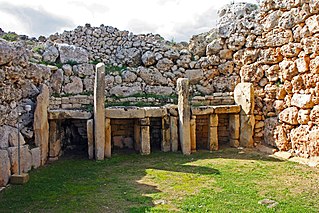
The Stone Age was a broad prehistoric period during which stone was widely used to make stone tools with an edge, a point, or a percussion surface. The period lasted for roughly 3.4 million years and ended between 4,000 BC and 2,000 BC, with the advent of metalworking. Though some simple metalworking of malleable metals, particularly the use of gold and copper for purposes of ornamentation, was known in the Stone Age, it is the melting and smelting of copper that marks the end of the Stone Age. In Western Asia, this occurred by about 3,000 BC, when bronze became widespread. The term Bronze Age is used to describe the period that followed the Stone Age, as well as to describe cultures that had developed techniques and technologies for working copper alloys into tools, supplanting stone in many uses.

The Oldowan was a widespread stone tool archaeological industry (style) in prehistory. These early tools were simple, usually made with one or a few flakes chipped off with another stone. Oldowan tools were used during the Lower Paleolithic period, 2.9 million years ago up until at least 1.7 million years ago (Ma), by ancient Hominins across much of Africa. This technological industry was followed by the more sophisticated Acheulean industry.

Behavioral modernity is a suite of behavioral and cognitive traits that distinguishes current Homo sapiens from other anatomically modern humans, hominins, and primates. Most scholars agree that modern human behavior can be characterized by abstract thinking, planning depth, symbolic behavior, music and dance, exploitation of large game, and blade technology, among others. Underlying these behaviors and technological innovations are cognitive and cultural foundations that have been documented experimentally and ethnographically by evolutionary and cultural anthropologists. These human universal patterns include cumulative cultural adaptation, social norms, language, and extensive help and cooperation beyond close kin.
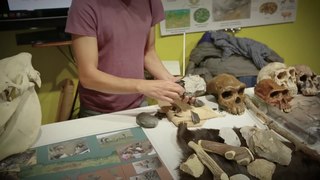
In the archaeology of the Stone Age, an industry or technocomplex is a typological classification of stone tools.
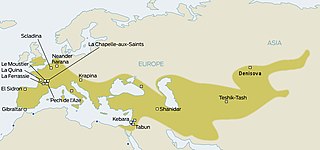
The Mousterian is an archaeological industry of stone tools, associated primarily with the Neanderthals in Europe, and to the earliest anatomically modern humans in North Africa and West Asia. The Mousterian largely defines the latter part of the Middle Paleolithic, the middle of the West Eurasian Old Stone Age. It lasted roughly from 160,000 to 40,000 BP. If its predecessor, known as Levallois or Levallois-Mousterian, is included, the range is extended to as early as c. 300,000–200,000 BP. The main following period is the Aurignacian of Homo sapiens.

Africa has the longest record of human habitation in the world. The first hominins emerged 6-7 million years ago, and among the earliest anatomically modern human skulls found so far were discovered at Omo Kibish, Jebel Irhoud, and Florisbad.
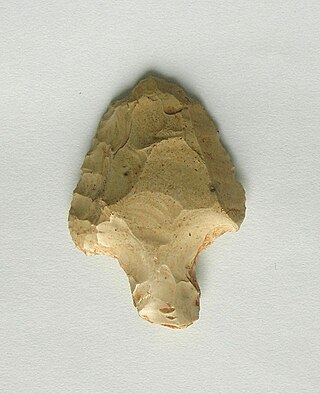
The Aterian is a Middle Stone Age stone tool industry centered in North Africa, from Mauritania to Egypt, but also possibly found in Oman and the Thar Desert. The earliest Aterian dates to c. 150,000 years ago, at the site of Ifri n'Ammar in Morocco. However, most of the early dates cluster around the beginning of the Last Interglacial, around 150,000 to 130,000 years ago, when the environment of North Africa began to ameliorate. The Aterian disappeared around 20,000 years ago.
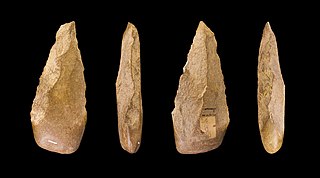
The Lower Paleolithic is the earliest subdivision of the Paleolithic or Old Stone Age. It spans the time from around 3.3 million years ago when the first evidence for stone tool production and use by hominins appears in the current archaeological record, until around 300,000 years ago, spanning the Oldowan and Acheulean lithics industries.

The Levallois technique is a name given by archaeologists to a distinctive type of stone knapping developed around 250,000 to 300,000 years ago during the Middle Palaeolithic period. It is part of the Mousterian stone tool industry, and was used by the Neanderthals in Europe and by modern humans in other regions such as the Levant.
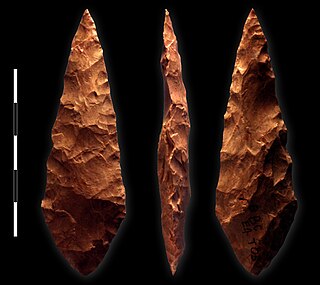
The Middle Stone Age was a period of African prehistory between the Early Stone Age and the Late Stone Age. It is generally considered to have begun around 280,000 years ago and ended around 50–25,000 years ago. The beginnings of particular MSA stone tools have their origins as far back as 550–500,000 years ago and as such some researchers consider this to be the beginnings of the MSA. The MSA is often mistakenly understood to be synonymous with the Middle Paleolithic of Europe, especially due to their roughly contemporaneous time span; however, the Middle Paleolithic of Europe represents an entirely different hominin population, Homo neanderthalensis, than the MSA of Africa, which did not have Neanderthal populations. Additionally, current archaeological research in Africa has yielded much evidence to suggest that modern human behavior and cognition was beginning to develop much earlier in Africa during the MSA than it was in Europe during the Middle Paleolithic. The MSA is associated with both anatomically modern humans as well as archaic Homo sapiens, sometimes referred to as Homo helmei. Early physical evidence comes from the Gademotta Formation in Ethiopia, the Kapthurin Formation in Kenya and Kathu Pan in South Africa.
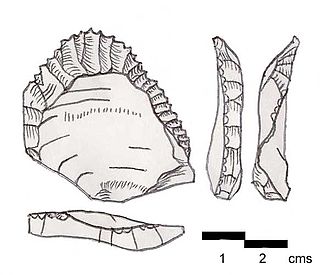
Ksar Akil is an archeological site 10 km (6.2 mi) northeast of Beirut in Lebanon. It is located about 800 m (2,600 ft) west of Antelias spring on the north bank of the northern tributary of the Wadi Antelias. It is a large rock shelter below a steep limestone cliff.
Prehistoric technology is technology that predates recorded history. History is the study of the past using written records. Anything prior to the first written accounts of history is prehistoric, including earlier technologies. About 2.5 million years before writing was developed, technology began with the earliest hominids who used stone tools, which they first used to hunt food, and later to cook.
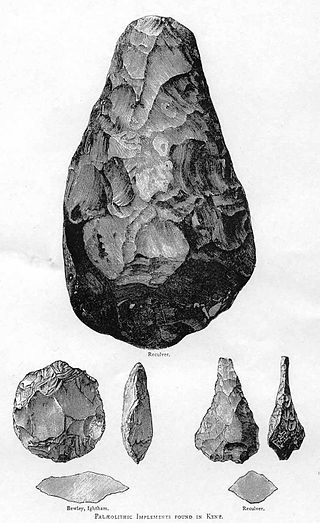
The following outline is provided as an overview of and topical guide to prehistoric technology.
Alison S. Brooks is an American paleoanthropologist and archaeologist whose work focuses on the Paleolithic, particularly the Middle Stone Age of Africa. She is one of the most prominent figures in the debate over where Homo sapiens evolved and when.

Southwest Asian Neanderthals were Neanderthals who lived in Turkey, Lebanon, Syria, Israel, Iraq, and Iran - the southernmost expanse of the known Neanderthal range. Although their arrival in Asia is not well-dated, early Neanderthals occupied the region apparently until about 100,000 years ago. At this time, Homo sapiens immigrants seem to have replaced them in one of the first anatomically-modern expansions out of Africa. In their turn, starting around 80,000 years ago, Neanderthals seem to have returned and replaced Homo sapiens in Southwest Asia. They inhabited the region until about 55,000 years ago.
The diet of known human ancestors varies dramatically over time. Strictly speaking, according to evolutionary anthropologists and archaeologists, there is not a single hominin Paleolithic diet. The Paleolithic covers roughly 2.8 million years, concurrent with the Pleistocene, and includes multiple human ancestors with their own evolutionary and technological adaptations living in a wide variety of environments. This fact with the difficulty of finding conclusive of evidence often makes broad generalizations of the earlier human diets very difficult. Our pre-hominin primate ancestors were broadly herbivorous, relying on either foliage or fruits and nuts and the shift in dietary breadth during the Paleolithic is often considered a critical point in hominin evolution. A generalization between Paleolithic diets of the various human ancestors that many anthropologists do make is that they are all to one degree or another omnivorous and are inextricably linked with tool use and new technologies. Nonetheless, according to the California Academy of Sciences, "Prior to about 3.5 million years ago, early humans dined almost exclusively on leaves and fruits from trees, shrubs, and herbs—similar to modern-day gorillas and chimpanzees."
The Ahmarian culture was a Paleolithic archeological industry in the Levant dated at 46,000–42,000 BP and thought to be related to Levantine Emiran and younger European Aurignacian cultures.

The Levantine Aurignacian is an Upper Paleolithic culture of the Near-Eastern Levant that evolved from the Emiran culture. It was named so because of the similarity of stone tools with the Aurignacian culture in Europe. The Levantine Aurignacian used to be called Lower and Upper Antelian in old sources, from the site of Wadi Antelias in Lebanon. The most important innovation in this period is the incorporation of some typical elements of Aurignacian, like some types of burins and narrow blade points that resemble the European type of Font-Yves.
















